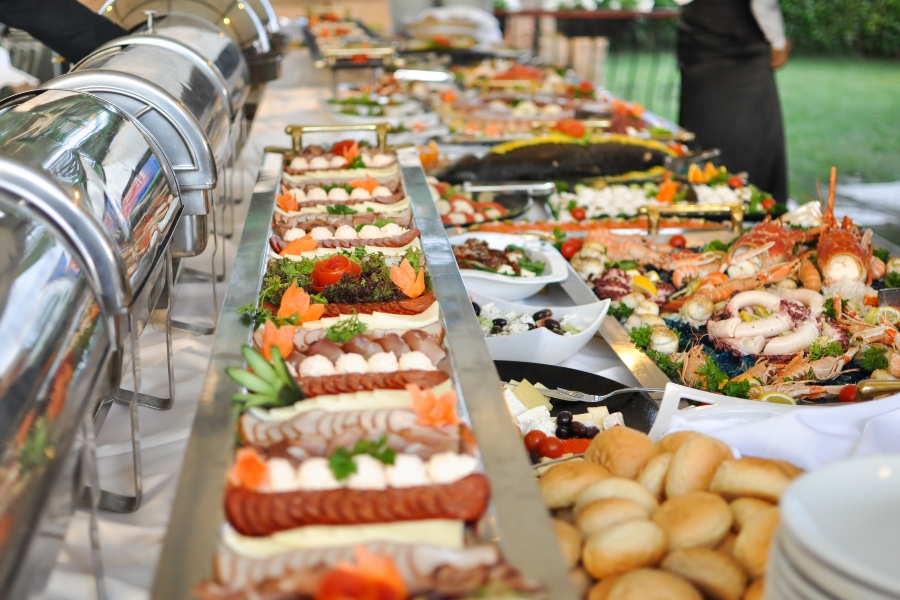
Food is more than sustenance; it’s an experience, a connection to the time of year and the environment around us. When planning an event, choosing a seasonal menu isn’t just a thoughtful touch—it’s an invitation for guests to savor the essence of the season. Seasonal menus emphasize freshness, flavor, and sustainability while celebrating the unique characteristics of each time of year. From the cozy warmth of fall to the vibrant medleys of summer, here’s a deeper dive into seasonal catering ideas to inspire your next gathering.
Fall: A Harvest Feast Full of Comfort
Fall is synonymous with rich, earthy flavors and comforting dishes. The season’s bounty offers an array of ingredients like squashes, apples, cranberries, and root vegetables, making it a perfect time to craft a menu that feels like a warm embrace.
Appetizers
Start your fall menu with starters that highlight seasonal flavors. Think creamy butternut squash soup served in petite shooter glasses with a garnish of crispy sage. Or opt for apple and brie crostini drizzled with honey—simple yet luxurious. For something heartier, offer caramelized onion tartlets or mini stuffed mushrooms with herbed breadcrumbs.
Main Courses
For the entrée, focus on hearty proteins and robust accompaniments. Maple-glazed pork tenderloin served with a side of roasted sweet potatoes and Brussels sprouts tossed in balsamic reduction makes for a showstopping centerpiece. For a vegetarian option, consider wild mushroom risotto with a hint of truffle oil or a stuffed acorn squash filled with quinoa, cranberries, and pecans.
Desserts
Desserts in fall are about celebrating warm spices and orchard fruits. Serve individual pumpkin cheesecakes, apple cider donuts, or caramel-drizzled pear tarts. Pair these sweet treats with spiced whipped cream for added decadence.
Drinks
No fall menu is complete without cozy beverages. Offer guests a warm spiced cider (spiked or not), a cinnamon old-fashioned, or a pumpkin ale to complement the meal. For non-alcoholic options, consider a chai tea latte or sparkling apple juice.
Winter: Indulgence and Elegance
Winter menus call for indulgent, warming dishes that bring people together during the colder months. This season’s offerings showcase decadent ingredients, hearty textures, and rich flavors.
Appetizers
Begin with comforting starters that set a festive tone. Mini beef Wellington bites wrapped in flaky puff pastry or creamy tomato bisque served with grilled cheese croutons are crowd-pleasers. For a lighter option, try smoked salmon on cucumber rounds or endive leaves filled with herbed cream cheese and pomegranate seeds.
Main Courses
The main event should feel like a feast. Braised lamb shanks served over garlic mashed potatoes or roast beef tenderloin with a red wine reduction make for unforgettable entrees. Vegetarian guests will appreciate a dish like spinach and ricotta-stuffed cannelloni in a velvety bechamel sauce.
Desserts
Indulge your guests with decadent desserts that embody winter’s opulence. Serve molten chocolate lava cakes with a dusting of powdered sugar, sticky toffee pudding topped with a dollop of whipped cream, or individual spiced pear tarts with caramel drizzle.
Drinks
Winter drinks should be warm and inviting. Think hot buttered rum, mulled wine, or a creamy eggnog spiked with brandy. For non-alcoholic options, serve peppermint hot chocolate or cranberry spritzers.
Spring: Fresh, Bright, and Invigorating
Spring represents renewal, and the menu should reflect this energy with light, fresh flavors and colorful presentations. Ingredients like asparagus, peas, radishes, and citrus are at their peak, making them ideal for a vibrant spread.
Appetizers
Capture the essence of spring with delicate starters. Serve asparagus spears wrapped in prosciutto or spring pea crostini topped with ricotta and mint. For seafood lovers, mini crab cakes with a lemon dill aioli make a fantastic option.
Main Courses
Focus on dishes that feel fresh and uplifting. Herb-crusted chicken with a lemon beurre blanc or grilled salmon with a side of spring vegetable medley are sure to impress. For vegetarian guests, offer a roasted artichoke and farro salad or stuffed portobello mushrooms with quinoa and spinach.
Desserts
Spring desserts should be light and fruit-forward. Serve lemon meringue tartlets, strawberry shortcake with freshly whipped cream, or lavender-infused panna cotta topped with honey drizzle and edible flowers.
Drinks
Pair the menu with floral or citrus-inspired beverages. Elderflower gin and tonics, sparkling rosé, or a basil lemonade will delight guests. Non-alcoholic options could include mint-infused iced tea or a cucumber cooler.
Summer: Bold, Bright, and Refreshing
Summer menus are all about showcasing juicy fruits, crisp vegetables, and smoky grilled flavors. This is the season for outdoor dining and playful presentations.
Appetizers
Serve vibrant starters like watermelon and feta skewers with a balsamic glaze or shrimp ceviche with avocado and lime. Chilled gazpacho shots or mini Caprese salad cups are also refreshing options for a hot summer day.
Main Courses
Grilled dishes shine in summer. Offer marinated flank steak with chimichurri or citrus-glazed chicken thighs with a side of sweet corn and heirloom tomato salad. For vegetarians, consider grilled eggplant roll-ups stuffed with ricotta and basil or summer squash boats filled with a Mediterranean couscous blend.
Desserts
Keep desserts simple yet refreshing. Serve peach cobbler with vanilla ice cream, berry trifles layered in mason jars, or tart lemon sorbet. These treats are light enough to enjoy after a hearty summer meal.
Drinks
Quench guests’ thirst with fruity and colorful beverages. Offer mojitos with fresh mint, strawberry basil lemonade, or classic sangria. Non-alcoholic options might include iced hibiscus tea or pineapple-infused water.
Why Seasonal Ingredients Matter
Seasonal menus are more than just a culinary choice—they’re a commitment to quality, sustainability, and flavor. Ingredients harvested in their natural season are fresher, more vibrant, and packed with nutrients. Think of the juiciness of a summer peach or the earthy sweetness of fall squash—these characteristics simply can’t be replicated with out-of-season produce.
Using seasonal ingredients also supports local farmers and reduces the environmental impact of long-distance transportation. It’s a way to honor the planet while delivering food that’s at its peak in both taste and presentation.
Seasonal dishes also create a connection between the meal and the time of year, enhancing the guest experience. They evoke memories and emotions tied to the season, making the event more meaningful and memorable.
Conclusion: Savor the Seasons
Catering with seasonal menus isn’t just about creating delicious food—it’s about crafting an experience that’s deeply tied to the time of year. From the warming comfort of a winter feast to the refreshing brightness of summer fare, every season offers a unique palette of flavors to inspire your menu. By embracing what’s fresh, local, and sustainable, you’ll not only delight your guests but also elevate your event into a celebration of nature’s bounty.
